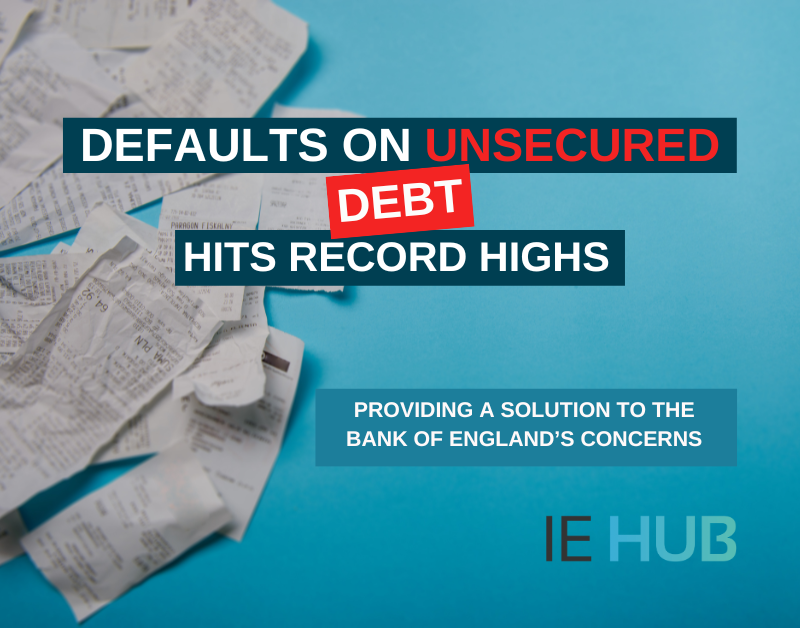
22 Jan
Defaults on Unsecured Debt Hits Record Highs- What is the Solution?
In the wake of recent reports indicating a sharp rise in defaults on unsecured debt in the UK, many individuals are finding themselves in problematic financial situations.
The Bank of England’s survey highlights an alarming trend: the highest expected increase in missed repayments on credit cards and loans since 2009.
This situation is compounded by the cost of living crisis and successive interest rate rises. This will be a troubling time for households across the nation.
Insights from The Bank of England
In light of the recent Bank of England survey, it’s even more evident that UK households are continuing to struggle financially. This situation highlights the importance of financial management tools like IE Hub in assisting individuals to navigate these difficulties.
The Current Financial Climate:
- Defaults on Unsecured Debt: The survey points to a concerning increase in defaults on unsecured debt. A net percentage balance of +31.7% indicates lenders are anticipating the largest rise in defaults on credit cards and personal loans. This is since the global financial crisis of 2009.
- Secured and Unsecured Lending Availability: While the availability of secured credit to households showed a minor increase (a balance of -4.2%), the outlook for the next quarter is expected to remain stable (a balance of 6.6%). On the other hand, unsecured credit availability remained unchanged. But, it is anticipated to see a slight uptick (from a balance of 10.4 to 2.4%).
- Demand for Housing and Remortgaging: A stark decrease in demand for secured lending for house purchases and remortgaging is noted, with net percentage balances of -31.6% for house purchases and -27.7% for remortgaging. However, there is an expected reversal in the trend. Iith anticipated increases to 21.9% for house purchases and 14.1% for remortgaging in the next quarter.
- Demand for Credit Cards and Other Unsecured Lending: There’s a reported decrease in demand for credit card lending (a balance of -23.1%), with an expected rebound (a balance of 35.5%). For other unsecured lending, the current decrease (a balance of -28.1%) is expected to stabilise (a balance of -0.4%).
- Corporate Lending Trends: For small businesses, a significant decrease in demand is reported (a balance of -23.9%), with expectations of near stabilisation (a balance of -1.6%). Medium and large businesses show a more steady state with slight expected increases (balances of 3.4% for medium and 9.5% for large businesses).
The Growing Financial Pressure with Defaults on Unsecured Debt
Households are increasingly strained due to higher borrowing costs due to continuous interest rate hikes since December 2021.
This financial pressure is not just theoretical; it’s a reality impacting real people, every day.
For those with unsecured debts like credit card balances or personal loans, the situation is particularly dire. It’s clear that a significant portion of the population is facing the grim reality of a debt disaster.
The Role of IE Hub as a Solution to Rising Defaults on Unsecured Debt
In these challenging times, effective financial management tools like IE Hub become more crucial than ever. IE Hub offers a beacon of hope and practical assistance to those struggling to navigate their financial commitments.
One-Stop Financial Information Sharing: IE Hub simplifies the process of managing financial data. It allows consumers to share a comprehensive Income & Expenditure (I&E) profile with partnering organisations. We are facilitating a mutual understanding of the consumer’s financial position. This approach enables creditors to tailor solutions that genuinely fit their customers’ needs, and make it more personalised and effective.
Personalised Debt Management Solutions: With the rise in defaults, managing existing debts becomes critical. IE Hub helps consumers understand and proactively tackle their debts. The ultimate end goal is to make managing repayments more effective. Our partnering clients leverage this transparency to provide informed and empathetic assistance, ensuring repayment plans are sustainable and fair.
Budgeting and Expense Tracking: IE Hub’s budgeting tools can be a lifeline for those struggling to align their expenses with their income. By tracking their income and expenditure, consumers can identify areas for cost-saving, which is essential in times of financial strain.
Free Benefits Checker: Moreover, IE Hub’s commitment to financial wellbeing extends to its free benefits checker, which has identified over £100 million in unclaimed benefits for users within a year. This service ensures that users are not missing out on any financial support they are entitled to. Thereby, enhancing their ability to manage expenses and debt more comfortably.
Conclusion: Facing Financial Headwinds with IE Hub
As we digest the realities presented, it’s clear that the path ahead for many households is fraught with financial challenges.
With rising debt defaults looming large and the cost of living crisis tightening its grip, the need for robust financial management tools has never been more pressing.
IE Hub emerges not just as a tool but as a must-have in these turbulent times. Its suite of features for managing financial information, personalised debt solutions, and budgeting offers a much-needed lifeline to those struggling.
IE Hub empowers consumers to stay ahead of their debts and manage their finances with confidence.